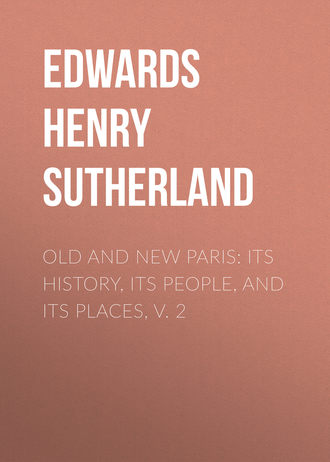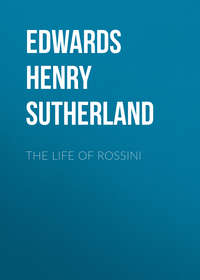
Old and New Paris: Its History, Its People, and Its Places, v. 2
Votary of romanticism as he had been, Sainte-Beuve adopted on one occasion a course which many would have considered the reverse of romantic. Challenged to a duel by M. Lecaze for words which he had uttered in the Senate, he replied that he would fight his adversary with no other weapon than that with which they were both familiar – the pen.
The death of Sainte-Beuve was preceded by cruel bodily tortures, and, as he saw his end approaching, he took precautions to keep the priests away from his bedside, and to divest his interment of all solemnity. By his testamentary wishes none of the associations to which he belonged, neither the Academy nor the Senate, was to be represented at his funeral; and no oration was to be pronounced over his tomb. “Finally,” he added, “I wish to be carried straight from my home to the cemetery of Montparnasse, and to be placed in the vault where my mother lies, without passing through the church, which I could not do without violating my sentiments.” His dying directions were obeyed to the letter.
CHAPTER XXXVI.
SPORTS AND DIVERSIONS
Le “Sport”– Longchamps – Versailles Races – Fontainebleau – The Seine – Swimming Baths – The Art of Book-collectingTHE Seine at Paris is the scene not of much boating, but of a good deal of swimming. Baths on the Thames have never been successful: they abound on the Seine, and the Parisians, whatever they may be as boatmen – “canotiers,” to use their own word – excel as swimmers.
The French are not naturally a sporting nation. In the first place they have found it necessary to borrow our English word for their pastimes; and their spelling of sportsman as “sportman” is somewhat indicative of their generally unsuccessful imitation of English sports.
The French are themselves conscious of the failure of this imitation. “Sport,” says a French writer, “is an English word which signifies literally relaxation, distraction, and which the English employ, by extension, to designate the pleasures to which powerful aristocrats or opulent citizens abandon themselves as a relaxation from the serious labours of political life or the absorbing occupations of commerce. In “sport” they include large hunts and shooting expeditions such as can be practised on vast estates, together with betting, which involves millions of pounds sterling, riding and driving, fencing, boxing, swimming, skating; everything which calls into play the forces and energy of the body, to the too frequent neglect of mental activity.
“We have adopted the word and attempted the thing. But independently of the fact that our French society lacks some of the fundamental conditions which, in this respect, English society possesses, we have done what imitators generally do: we have diminished, sometimes even travestied the model. Large aristocratic hunts have become impossible on our democratic and parcelled-out soil. Well-bred horses cost a great deal of money, and the instability of fortunes is an obstacle to fine stables. The most reckless of our millionaires only hazard a few thousand francs in the way of bets, and it is now generally understood that when a “louis” is spoken of on the turf, the ambitious word must be translated into the more modest expression, “twenty sous.” … Even fencing is abandoned to fiction and the stage. Duellists who are at all serious must go beyond the frontier to find a ground which will place combatants and seconds beyond the reach of the French law. The police-court of the nineteenth century is perhaps more dreaded than was the scaffold of Richelieu.”
Parisian summers, this same writer goes on to observe, are on the whole too cold for bathing, and Parisian winters too hot for skating.
Unquestionably horse-racing has taken a certain hold on the French, though it is true that the crowds who frequent the most popular races do not confine their attention, or their conversation, to the horses or the stakes, but regard the event principally as a fête.
It is at the hippodrome of the Bois de Boulogne (or Longchamps, as it is also called) that the most largely attended races occur. A minimum charge of a franc is made for admission, to stand or walk about outside the ropes which mark off the course. For the reserved places higher prices are charged: five francs to the pavilions, twenty francs to the weighing enclosure, fifteen francs for a one-horse carriage, twenty francs for a carriage with more than one horse, and so on. The races of La Marche are in the form of steeple-chases. The Château de La Marche stands in a park at a short distance from Ville d’Avray and Saint-Cloud; and it is in the park that the races take place.
The races of the Bois de Vincennes are less fashionable than those of Longchamps and of La Marche, perhaps because the approach to Vincennes through crowded streets is less attractive than the drive through the Champs Élysées and the Bois de Boulogne.
The races of Chantilly, founded in 1834 under the patronage of the Dukes of Orleans and of Nemours, are run twice a year on the spacious meadows which extend right and left of the magnificent stables of the château of the Condés. The first races are fixed for the second fortnight of May. The later series, those of the autumn meeting, are held in September and October. The last race of the season is for the grand prize of the Jockey Club. The racecourse of Chantilly describes an ellipsis measuring some 2,000 metres. Several stands have been erected opposite the stables: prices of admission to the various places as at Paris. At Chantilly are the principal training establishments.
The Versailles races are run on the plain of Satory, where Napoleon III. held some of his most brilliant reviews. They take place in May and June.
At Fontainebleau the races are run on a course cut through the part of the forest known as the Valley of the Solle. From various woody heights the spectator, well protected from the sun, can obtain an excellent view of the running. Shooting is practised at a club in the little town of Argenteuil, close to Paris, where the society of Parisian Riflemen is established. Candidates duly proposed and seconded are put up for election, and, if admitted, pay ten francs entrance money and an annual subscription of fifty francs. The organ of the society is the well-known sporting paper, the Journal des Chasseurs.
The canotiers and canotières of the Seine are counted by thousands. They all seem to row more for amusement than for exercise and pace. The principal ports of the Parisian navy are Charenton above bridge, and Asnières below. Charenton may be reached by the Lyons Railway: the charming Asnières (famous for its balls) by the Saint-Germain and Versailles line. The water-side restaurants are organised in view of the canotiers, and appeal specially to this floating population.
If the Seine is remarkable for its swimming baths and, at some little distance on each side of Paris, for its innumerable boats with rowers and rowed in gay fantastic costumes, one bank of the Seine, the left, is celebrated for its stalls of second-hand books. It was at a curiosity shop on one of the quays of the left bank that Balzac’s “Peau de Chagrin” or “Chagreen Skin” was offered for sale. It was at a neighbouring bookstall that the poor student in the “Vie de Bohème” sold his Greek books for little more than the price of waste paper in order to buy medicine for the dying mistress of his friend. It is not at the bookstalls of the Quai d’Orsay that one would look for the rarest editions, though rare editions may here be found. There are connoisseurs who seem to spend every day and all day long at the bookstalls of the quay; resembling the celebrated English bibliophile, Lord Spencer, who remained an entire year at Rome, visiting neither St. Peter’s, nor the Coliseum, nor the Vatican, but only the old bookshops. When he had once found the Martial of Sweynheym and Pannartz dated 1473 he went straight back to London. Such a passion looks like insanity; but it is at least a respectable, innocent kind of madness. To have a genuine passion for books is to care neither for cards, nor for good living, nor for useless luxury, nor for racehorses, nor for political intrigues, nor for ruinous love affairs. The bibliophile is never troubled by the storms of political life. Pixéricourt, the author of thirty amusing or terrible novels, would be forgotten in France but for the rare editions that he collected in his library, and which after his death did more for his reputation, at the sale of his books, than all his works of fiction had done. Few writers of the day grudged him his talent or his success; but many envied him his “Imitation of Jesus Christ,” given to the monk Laurence “by his very humble servant, Pierre Corneille.” His Elzevirs and Baskervilles, for which Holland and China had furnished their rarest paper, England and France their best engravers, Russia and Morocco their incomparable leather, filled amateurs with enthusiasm. A great French book-collector, Grolier, had adopted this motto, “For myself and my friends.” Charles Nodier wrote for Pixéricourt an epigraph to be inscribed inside his books which, if somewhat selfish, was at least true:
Tel est le triste sort de tout livre prêté,Souvent il est perdu, toujours il est gâté.4The bookstall-keeper acquires gradually a knowledge of the finest or, if not the finest, the most curious editions; and he would be but a poor dealer were he unable to judge of their value. At one time the Pont-Neuf was full of bookshops; and the second-hand dealers in books had their stalls in the Cité, close to Notre Dame and to the Palace of Justice, as well as on the Place de Grèves. But they are now nearly all to be found on the parapets of the left bank.
The picture-dealers, at one time numerous on the quays of the left bank of the Seine, have for years past been gradually disappearing. It was in the curiosity shop already mentioned in connection with Balzac’s “Peau de Chagrin” that a certain Christ, by Raphael, was supposed to be kept hidden away like a treasure. That, however, was more than sixty years ago; and no masterpieces by Raphael are now to be found in the curiosity shops of the left bank. The one place for buying and selling pictures is the Hôtel Drouot, on the other side of the river. Here pictures are sold by auction at the hands of official auctioneers and authorised brokers. In addition to the purchase-money five per cent. must be paid in the way of fees and for the cost of the sale. This charge is thought exorbitant, and it has not been forgotten that at the sale of Marshal Soult’s pictures, when Murillo’s “Conception” was purchased by the Government for the Square Room of the Louvre, nearly 30,000 francs commission had to be paid independently of the 586,000 francs, which was the adjudicated price. The sales about to take place are announced on the walls of the Hôtel Drouot; also in the columns of certain journals, such as the Moniteur des Ventes or the Chronique des Arts.
CHAPTER XXXVII.
FENCING SCHOOLS
Fencing in France – A National Art – Some Extracts from the Writings of M. Legouvé, One of its Chief Exponents – The Old Style of Fencing and the NewFENCING is in England the pastime of a few amateurs; in France it is a national art. An ingenious reason has been adduced by M. Legouvé why proficiency with the rapier should be acquired by everyone. “The sword,” he writes, “possesses the finest of all advantages: it is the only weapon with which you can avenge yourself without an effusion of blood. What is nobler for a man of chivalry and skill when he finds himself confronting the man who has offended him, and whom he is privileged to kill, than at once to punish this adversary and to spare his life – to disarm him, that is to say.”
It is in his character of dramatic author, however, that M. Legouvé chiefly values duelling. “What would become of us wretched playwrights without the sword-duel?” he asks. “The pistol is a brutal contrivance, suitable only to dark melodramas and to dénouements… What do you think could be done in a comedy with a man who haply had received a bullet wound? He is no longer good for anything. But if he has been wounded with a sword, he returns two minutes afterwards with his hand thrust in the folds of his waistcoat and an attempted smile on his face. The young woman says to him, ‘How pale you are!’ ‘I, mademoiselle?’ Then the end of a bandage is somehow perceived. ‘Gracious heavens! you have been fighting a duel,’ she exclaims.” M. Legouvé must now be allowed to continue in his own language: “Ah! l’admirable verbe que le verbe se battre! Tous les temps en sont bons. Vous vous battez? battez-vous!.. Ne vous battez pas!.. Et comme il va bien avec les exclamations: ‘Mon ami! par grâce! Monsieur, vous êtes un lâche!.. Arthur! Arthur!.. Je me jette à tes pieds!’ Speak not to me of dramatic writing without those two indispensable collaborators: love and the sword.
“Fencing interests me, moreover, simply as an observer. A fencing-school is a theatre at which as many amusing characters may be seen as on any stage. First of all there is a class of fencers who do not fence and never will. Then there are the men who fence in order to reduce their bulk; who have been told by their doctor or their wife that they are too fat, and who, after sweating like oxen, blowing like seals, steaming like boiled puddings, for a couple of hours, tell you in the calmest manner that they have been fencing.
“Then there are the fencing-masters, or professors of fencing, as they prefer to be called. They are generally gay, good-natured, well-meaning fellows, devoted body and soul to their pupils, especially to those pupils who have done them the honour to kill someone in mortal combat. Their weak point is said to be veracity; not on all occasions, but whenever they have the foil in hand. “I have never,” says M. Legouvé, “met a single fencer who would not – say once every year – deny that he had been touched when the hit was palpable. It is so easy to say ‘I did not feel it,’ and a hit not recognised does not count. Ah, if we dramatists could only annul hisses by saying: ‘I did not hear them!’
“My first professor,” continues M. Legouvé, “was an old master known as Père Dularviez. He had a daughter of whom he was exceedingly proud. She was employed in a milliner’s shop, which caused her father some uneasiness as to her possible conduct. There was nothing to justify his uneasiness, but he was uneasy. At last, unable to rest, he wrapped himself up in a cloak and took up his position at the corner of the Rue Traversière, close to the Rue Saint-Honoré, where his daughter worked. ‘You may imagine,’ he said to us, ‘how my heart beat when I saw her appear. I approached her, and averting my face, whispered in her ear a graceful little compliment which I had invented for the occasion. O joy! she turned round and administered to me with all her might a box on the ear. I guarded myself en tierce and said: ‘My child, you are truly virtuous.’
“Fencing has, moreover, its utilitarian value. It teaches you to judge men. With the foil in hand no dissimulation is possible. After five minutes of foil-play the false varnish of mundane hypocrisy falls and trickles away with the perspiration: instead of the polished man of the world, with yellow gloves and conventional phrases, you have before you the actual man, a calculator or a blunderer, weak or firm, wily or ingenuous, sincere or treacherous… One day I derived a great advantage. I was crossing foils with a large broker in brandies, rums, and champagnes. Before the passage of arms he had offered me his services in regard to a supply of liquors, and I had almost accepted… The fencing at an end, I went to the proprietor and said: ‘I shall buy no champagne of that man.’ ‘Why not?’ ‘His wine must be adulterated – he denies every hit.’
“Apply my principle, and you will find it profitable. Some of you are already married. One day you will have daughters to marry. Well, if a suitor presents himself, do not waste time in collecting particulars which are too often false. Say simply to your future son-in-law: ‘Will you have a turn with the foils?’ At the end of a quarter of an hour you will know more about his character than after six weeks of investigations.
“Finally, I like fencing because you cannot learn it. It does, indeed, demand practice, and long practice; but that is not sufficient, it must be your vocation: you must be born a fencer, just as you must be born an artist. And then, when the apprenticeship has been served, what pleasure is enjoyed! I doubt whether there is in external life a single act in which a man feels himself to live more fully than in a vigorous assault.
“Look at the fencer in action. Each member, each muscle is stretched, and each for a different purpose. Whilst the hand glances rapidly and lightly, always tending forwards, the body holds itself back, and the legs, vigorously contracted like a spring, await, for their extension, the signal to be given by the arm as it prepares to make its sudden thrust. The whole of the members are like so many obedient soldiers to whom the general says: ‘March’ – ‘Halt’ – ‘Double.’ The general is the head, that head which, at once inspired and calculating as though on a real field of battle, detects at a glance the faults of the enemy, lays traps for him and compels him to fall into them, simulates a retreat in order to give him confidence, and returns suddenly upon him with a frightful assault…
“And to think that this art, complex as it is, in which the whole of the body is engaged, should really be concentrated between the end of the forefinger and the thumb. For there it all is: there resides the delicate and masterly faculty which alone constitutes the superior fencer – tact. Is it not wonderful to see how much sensibility and life flows between these two digits? They tremble, they palpitate beneath the pressure of the foil in contact with their own, as if an electric current communicated to them all its movements. For them the aid of sight is not necessary, for they do more than see the hostile sword; they feel it, they could follow it with their eyes bandaged; and if you add to these magnificent delights of the sense of touch the powerful circulation of the blood which runs in great waves through the veins, the beating heart, the boiling head, the throbbing arteries, the heaving breast, the opening pores; if you join, moreover, to this the delight of feeling your power and your suppleness increase tenfold; if you think, above all, of the ardent joy and bitter grief of self-love, of the pleasure of beating and the vexation of being beaten, and of the thousand vicissitudes of a struggle which terminates and begins again at each fresh thrust – you will understand that there is in the exercise of this art a veritable intoxication, of which the passion for gambling can alone give an idea. It is play without vice and with health superadded.”
M. Legouvé, who, besides being an admirable writer, possesses no superficial knowledge of fencing, next proceeds to a few detailed observations on the art of the foil and its professors. We can hardly do better than preserve his own words. “Fencing,” he says, “has undergone during the last half-century the same revolution as poetry, music, and painting. It has had its romantic period and its contending schools.
“The distinguishing characteristics of the old school were rigidity, grace, and a certain academic elegance. The words themselves express the thing. To practise fencing was to ‘go to the Academy.’ A fencer of the old school could not run to the attack, nor suddenly break off. He neither bent down nor sprang forward, but under all circumstances maintained, more or less, the same attitude. Fencing was in those days, above all things, an art; which, like every art, had the beautiful for aim.
“Very different was the system of the new school. To make hits was its one object. The means were of no importance, provided the result could be obtained. Fencing was now more a combat than an art; its programme included everything, even the ugly. Fencers would now lie on the ground, would avoid a thrust by ducking their head, aim below the belt, and reduce all the qualities of the fencer to one only: rapidity.
“Gomard and Charlemagne were the two last representatives of the old school: Roussel and Lozes the two first of the new one. I have had the honour, in my youth, of fencing with all four; and I do not hesitate to say that, in my opinion, while fully recognising the incomparable quickness of Lozes, the superiority rested altogether with the representatives of the old school. Fencing ran the risk not of being renewed, like poetry, in another form, but of being lost altogether, at least as an art. Then came forward a young man who combined in himself the opposite qualities of the two schools. Every lover of fencing will understand that I am referring to Bertrand. As rapid as Lozes and as regular as Gomard, he borrowed from romanticism its audacity, its inspiration, its occasional rashness, and preserved at the same time the elegance of bearing, the severity of attitude, the caution and the science of the classical school. He may fairly be said, in company with Cordelois and Pons the elder, to have saved the art of fencing. He is an exceptional fencer among exceptional fencers. If I may be allowed to use the expression, there is genius in his art. The fencing-masters who came next were the products, somewhat mixed, of the three schools; the four professors who figure in the first rank being MM. Robert the elder, Gâtechair, Mimiague, and Pons the younger. Robert has a quickness of hand, an accuracy of attitude, and a rapidity of reply which recalls Bertrand. Gâtechair is the most academic of the masters of the present day. There is, however, something a little theatrical in his elegance and in his imposing carriage.
“Mimiague is supple, insinuating, adroit, sure to profit by every opportunity. There is a sort of cajolery in his play. If you ask who is the best of these four professors, I shall recommend you to apply the test of Themistocles. Bring together the principal fencing-masters of Paris, and ask them to write on a slip of paper the names of the two best fencers in Paris. Each of them will give the first vote to himself; but Robert will have all the second votes: from which I conclude that he deserves the first.”
CHAPTER XXXVIII.
PETTY TRADES
Petty Trades – Their Origins – The Day-Banker – The Guardian Angel – The Old-Clothesman – The Claque – Its First Beginning and DevelopmentTHE police of Paris are very strict in suppressing those trades bordering upon mendicancy, which in London are somewhat freely allowed. Many of the former hawkers of inexpensive trifles have been permanently swept away from the streets of Paris.
The Galileo of the Place Vendôme, however, is still permitted to carry on his business. As soon as the gas is alight, this personage, somewhat fantastically dressed, levels his telescope, after having traced in chalk on the pavement a picture of the moon, with its mountains, ravines, and so forth. In consideration of a slight recognition, varying from 25 to 50 centimes, he shows his clients all the astronomical phenomena, including some which have escaped the notice of the Observatory.
“Nearly all the petty industries not classed in the Dictionary of Commerce are,” says a French writer, “the product of an imagination over-excited by the gnawings of the stomach. The first person who picked up, on the highway, a cigar-end, and then another and another, and who, after chopping them all up, sold the results as smoking-tobacco, did not deliberately adopt this profession in the same way that a person becomes an administrator or a lawyer. It was the necessity of eating that launched him into this career. Presently he held this argument, based upon statistics: – Every day in Paris at least three hundred thousand cigars are smoked. There must, therefore, be somewhere, and particularly beneath the outdoor tables of the boulevard cafés, three hundred thousand fag-ends. Thus the horizon opens to him. He perceives a magnificent commercial enterprise and takes partners. A new kind of manufacturer has now come into being: a manufacturer of unlicensed tobacco.”
Apparently the commodity sells well; and in the retort of a pipe the eclectic composition is as agreeable to the taste as the privileged product of the imperial factories. Some of the contraband dealers in cigar-ends have made a small fortune.





